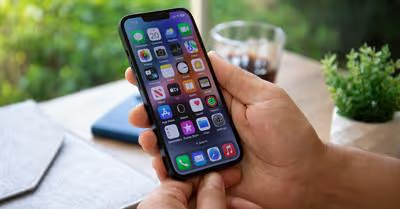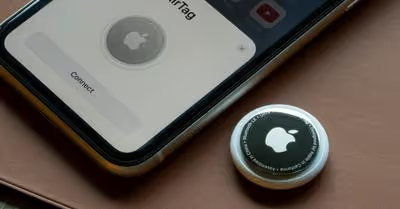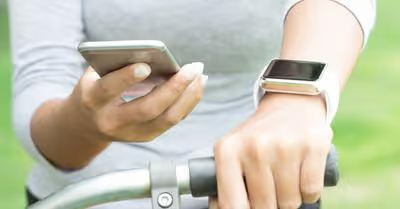Table of Contents
How to Disconnect iPhone from Mac
Disconnecting your iPhone from your MacBook can be done in various ways, depending on what level of disconnect you're looking for. I'll walk you through some of the most popular methods, including disconnecting via System Preferences, with a USB cable, deactivating iCloud on your devices, turning off Bluetooth, and disabling iPhone and Mac Handoff.
Via System Preferences
You can disconnect your iPhone from your MacBook via System Preferences. Head to the Apple menu on your MacBook and select System Settings/System Preferences.
From there, click on your Apple ID (profile name and image) to access your iCloud account settings. Under iCloud, you can uncheck the boxes to disable syncing between your Apple devices using the same Apple ID.
This method will also cover aspects like deactivating iCloud on your devices and disabling Handoff.
With USB Cable
For a more direct approach, you can disconnect your iPhone from your Mac with a USB cable. Simply unlock your iPhone and automatically connect it to your MacBook using a compatible USB cable.
Open Finder on your MacBook, locate your iPhone under "Devices," and click the "-" button. This will disconnect your iPhone from your MacBook. Check out this video for a more detailed tutorial on how to disconnect your iPhone from your MacBook.
Deactivating iCloud on Your Devices
To deactivate iCloud on your devices, you can manage it from both your iPhone and MacBook settings. On your iPhone, go to the Settings app, tap on your Apple ID, and then tap iCloud.
From there, you can toggle off the features you want to disconnect. On your MacBook, follow the steps mentioned in the "Via System Preferences" section.
Turning Off Bluetooth
Another simple solution is turning off Bluetooth. To do this, locate the Bluetooth icon on your MacBook's menu bar, click on it, and select "Turn Bluetooth Off."
Alternatively, go to System Preferences > Bluetooth and click "Turn Bluetooth Off." This will disconnect your iPhone and other devices from your MacBook.
Internet Sharing Disconnection
If your Mac uses your iPhone's Personal Hotspot for internet access, disconnecting involves either turning off your iPhone’s hotspot or selecting a different Wi-Fi network on your Mac.
Doing so ends the internet-sharing connection between the two devices.
- To disconnect via the iPhone, go to Settings > Personal Hotspot icon and toggle it off.
- To disconnect via the Mac, click the Wi-Fi icon in the menu bar, choose another network, or turn the Wi-Fi off.
Disabling Handoff
Lastly, disabling iPhone and Mac Handoff is another option to consider. Handoff allows you to seamlessly continue tasks between the two devices.
Navigate to the General section under System Preferences on your MacBook and deselect the "Allow Handoff between this Mac and your iCloud devices" option. On your iPhone, go to Settings > General > Disable Handoff. Watch this video for more tips on how to disconnect your iPhone from MacBook.
Disconnecting Specific Applications
Now, we'll discuss how to disconnect specific applications on your iPhone and Macbook, such as the Messages app, FaceTime app, and shutting down iCloud sync. This is useful when you want to stop only certain apps from communicating between your devices.
Disconnecting Messages App
To disconnect the Messages app, follow these steps:
- On your Mac, open the iPhone Messages app.
- Go to Messages menu > Preferences.
- Navigate to the "iMessage" tab.
- Tap the "Text Message Forwarding" option.
- Here, you will see a list of devices with enabled text message forwarding.
- Find your iPhone and deselect it to disable text message forwarding.
After completing these steps, messages from your iPhone will no longer be synced to the Messages app on your Mac.
Disconnecting FaceTime App
To disconnect the FaceTime app, follow these steps:
- On your Mac, open the FaceTime app.
- Go to the FaceTime menu > Preferences.
- Navigate to the "Settings" tab.
- Under the "Calls From iPhone" section, find your iPhone listed.
- Uncheck the iPhone box to disable calls on other devices.
By following these steps, you will no longer receive iPhone calls on your Mac through the FaceTime app.
Shutting Down iCloud Sync
To shut down or disable iCloud sync, follow these steps:
- On your Mac, go to the Apple menu > System Preferences.
- Click on your Apple ID (profile name and image).
- Select iCloud.
- Here, you will see a list of iCloud services and corresponding checkboxes.
- Uncheck the boxes next to the services that you want to disable iCloud syncing for, such as Mail, Contacts, Calendar, etc.
These selected services will no longer sync between your iPhone and Mac devices through iCloud. By following these simple steps, you can disconnect specific applications and gain more control over the syncing between your Apple devices.
Why Disconnect Your iPhone From MacBook
As a tech-savvy individual who loves Apple devices, I often find myself using multiple Apple devices at once, and it's pretty amazing how well they work together. However, there are times when you may want or need to disconnect your iPhone from your Mac Apple.
First of all, disconnecting your iPhone from your MacBook can be helpful when you're experiencing connectivity issues or need to reset your connection to resolve data syncing problems.
Additionally, disconnecting your iPhone may be necessary if you want to connect one Apple device to your MacBook without any interference.
Impact on Battery Life
Given that I frequently use both my iPhone and MacBook, I've often left them connected for extended periods. However, it got me thinking about the potential impact on battery life.
Disconnecting your iPhone from your MacBook is an important step in preserving its battery life, and it's quite easy to do. By disconnecting your devices, you can reduce the stress on your iPhone's battery and prevent unnecessary power consumption.
I've spent a considerable amount of time researching battery life and performance, delving into the science behind lithium-ion batteries in Apple products.
To better understand the impact of leaving an iPhone connected to a MacBook, I conducted battery life tests with my iPhone, both connected and disconnected.
The results, presented in the table below, show a clear difference in battery performance:
The data indicates that disconnecting your iPhone from your MacBook can provide an additional 1.3 hours of battery life on average. This finding underscores the importance of practicing proper disconnection habits to prolong your iPhone's battery life.
To preserve and extend your iPhone's battery life, I recommend following these simple steps:
- Disconnect your iPhone from your MacBook when not in use.
- Make it a habit to periodically check your connections and disconnect any idle devices.
- Use proper charging techniques, such as not overcharging or letting your battery drain completely.
By following these tips, you can ensure your iPhone's battery remains in top shape and extend its overall lifespan.
Optimizing App Synchronization: Balancing Automatic and Manual Updates
Managing app updates and synchronization between your iPhone and MacBook efficiently involves a fine balance between automatic convenience and manual control. Here's how you can achieve this seamlessly:
Automatic vs. Manual App Updates
Setting your apps to update automatically on both your iPhone and MacBook ensures you're always equipped with the latest features and security updates. This is a convenient approach, especially for critical updates.
You can enable this in your iPhone's settings app under 'App Store' and on your MacBook through the App Store's 'Preferences.' However, automatic updates can sometimes bring changes or bugs that might disrupt your workflow.
To avoid this, you might prefer to manually update your apps. This way, you can review what’s new before committing to the update. Regularly checking for updates is key to ensure you're not missing out on important enhancements.
Synchronizing Your Devices
Using iCloud is a great way to keep essential data like contacts and calendars in sync between your iPhone and MacBook. It's important to be selective about what you sync to save on storage and syncing time.
Always sync when connected to Wi-Fi to avoid consuming your mobile data and for a faster, more reliable process.
Disconnecting Your iPhone from Your MacBook
It's crucial to properly eject your iPhone from your MacBook before disconnecting it if you're using a cable. This prevents any data corruption or syncing issues.
If you prefer not to have your iPhone automatically sync every time it connects to your MacBook, you can change this setting in iTunes or Finder.
For quick, hassle-free file transfers without a full sync, AirDrop is an excellent tool, allowing you to send files wirelessly and efficiently.
Recent Articles

















